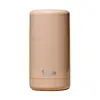What's inside
What's inside
 Key Ingredients
Key Ingredients

 Benefits
Benefits

 Concerns
Concerns

 Ingredients Side-by-side
Ingredients Side-by-side

Cocos Nucifera Oil
MaskingSolanum Tuberosum Starch
AbsorbentCoco-Caprylate/Caprate
EmollientHelianthus Annuus Seed Wax
Skin ConditioningCarthamus Tinctorius Seed Oil
MaskingPolyhydroxystearic Acid
EmulsifyingTriethyl Citrate
MaskingZinc Ricinoleate
Magnesium Hydroxide
AbsorbentLauryl Laurate
Skin ConditioningSambucus Nigra Fruit Extract
AstringentGlyceryl Laurate
EmollientSalvia Officinalis Oil
MaskingHelianthus Annuus Seed Oil
EmollientTocopherol
AntioxidantGlyceryl Caprylate
EmollientGlyceryl Undecylenate
EmollientEthylhexylglycerin
Skin ConditioningSodium Caproyl/Lauroyl Lactylate
AntimicrobialCocos Nucifera Oil, Solanum Tuberosum Starch, Coco-Caprylate/Caprate, Helianthus Annuus Seed Wax, Carthamus Tinctorius Seed Oil, Polyhydroxystearic Acid, Triethyl Citrate, Zinc Ricinoleate, Magnesium Hydroxide, Lauryl Laurate, Sambucus Nigra Fruit Extract, Glyceryl Laurate, Salvia Officinalis Oil, Helianthus Annuus Seed Oil, Tocopherol, Glyceryl Caprylate, Glyceryl Undecylenate, Ethylhexylglycerin, Sodium Caproyl/Lauroyl Lactylate
Caprylic/Capric Triglyceride
MaskingOzokerite
Emulsion StabilisingTapioca Starch
Parfum
MaskingZinc Ricinoleate
Water
Skin ConditioningSalicylic Acid
MaskingAscophyllum Nodosum Extract
Skin ConditioningLaminaria Digitata Extract
Skin ProtectingCalophyllum Inophyllum Seed Oil
AntimicrobialSaccharomyces Ferment
Skin ConditioningLauroyl Lysine
Skin ConditioningGlycerin
HumectantCocos Nucifera Oil
MaskingButyrospermum Parkii Butter
Skin ConditioningIngredients Explained
These ingredients are found in both products.
Ingredients higher up in an ingredient list are typically present in a larger amount.
Cocos Nucifera Oil is obtained from the kernels of the coconut fruit. In other words, this is coconut oil.
Coconut Oil is rich in fatty acids with lauric acid making up the majority of these. It also contains linoleic acid. Due to this high fatty acid content, coconut oil helps trap moisture and soften skin.
Despite being antibacterial, coconut oil may not be great for acne-prone skin. It is comedogenic and may clog pores. This ingredient may not be safe for malassezia or fungal acne.
Note: Coconut Oil should not replace your sunscreen for UV protection. Studies show it only blocks about 20% of UV.
This oil is non-volatile and has a light scent.
The term 'fragrance' is not regulated in many countries. In many cases, it is up to the brand to define this term. For instance, many brands choose to label themselves as "fragrance-free" because they are not using synthetic fragrances. However, their products may still contain ingredients such as essential oils that are considered a fragrance.
Learn more about Cocos Nucifera OilWe don't have a description for Zinc Ricinoleate yet.